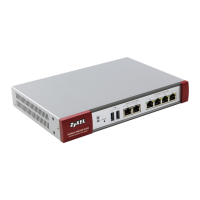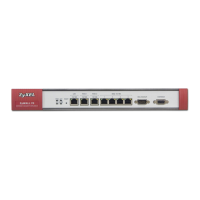Chapter 9 Interfaces
USG20(W)-VPN Series User’s Guide
158
Gateway This option appears when Interface Type is external or general. Enter the IP
address of the gateway. The USG sends packets to the gateway when it does not know
how to route the packet to its destination. The gateway should be on the same network
as the interface.
Metric This option appears when Interface Type is external or general. Enter the priority
of the gateway (if any) on this interface. The USG decides which gateway to use based
on this priority. The lower the number, the higher the priority. If two or more gateways
have the same priority, the USG uses the one that was configured first.
Enable IGMP
Support
Select this to allow the USG to act as an IGMP proxy for hosts connected on the IGMP
downstream interface.
IGMP Upstream Enable IGMP Upstream on the interface which connects to a router running IGMP that
is closer to the multicast server.
IGMP
Downstream
Enable IGMP Downstream on the interface which connects to the multicast hosts.
IPv6 Address
Assignment
These IP address fields configure an IPv6 IP address on the interface itself.
Enable Stateless
Address Auto-
configuration
(SLAAC)
Select this to enable IPv6 stateless auto-configuration on this interface. The interface
will generate an IPv6 IP address itself from a prefix obtained from an IPv6 router in the
network.
Link-Local
address
This displays the IPv6 link-local address and the network prefix that the USG generates
itself for the interface.
IPv6 Address/
Prefix Length
Enter the IPv6 address and the prefix length for this interface if you want to use a
static IP address. This field is optional.
The prefix length indicates what the left-most part of the IP address is the same for all
computers in the network, that is, the network address.
Gateway Enter the IPv6 address of the default outgoing gateway using colon (:) hexadecimal
notation.
Metric Enter the priority of the gateway (if any) on this interface. The USG decides which
gateway to use based on this priority. The lower the number, the higher the priority. If
two or more gateways have the same priority, the USG uses the one that was
configured first.
Address from
DHCPv6 Prefix
Delegation
Use this table to have the USG obtain an IPv6 prefix from the ISP or a connected uplink
router for an internal network, such as the LAN or DMZ. You have to also enter a suffix
address which is appended to the delegated prefix to form an address for this
interface. See Prefix Delegation on page 145 for more information.
To use prefix delegation, you must:
• Create at least one DHCPv6 request object before configuring this table.
• The external interface must be a DHCPv6 client. You must configure the DHCPv6
request options using a DHCPv6 request object with the type of prefix-delegation.
• Assign the prefix delegation to an internal interface and enable router
advertisement on that interface.
Add Click this to create an entry.
Edit Select an entry and click this to change the settings.
Remove Select an entry and click this to delete it from this table.
# This field is a sequential value, and it is not associated with any entry.
Delegated
Prefix
Select the DHCPv6 request object to use from the drop-down list.
Table 64 Configuration > Network > Interface > Ethernet > Edit (continued)
LABEL DESCRIPTION

